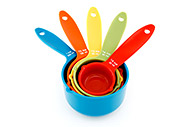
Research suggests that mindful eating can help you lose weight and keep it off. Defined as being fully aware and present during a meal, mindful eating contributes to healthier food choices, slower eating, improved hunger signals, and enjoyment. There are many ways to incorporate more mindful eating into your day.
Change your menu.
Falling into a rut is easy. Trying new foods, cooking styles, and types of cuisine will make you more mindful of what you put in your mouth.
Take small bites.
Big bites contribute to eating too quickly. This prevents you from truly enjoying your food. Reduce the size of your bites by at least 1/3 and chew slowly to improve your focus at meal time.
Put down the fork.
Set down your fork at least every two to three bites. This pause will slow your eating and create a more mindful experience.
Use chopsticks.
Forks allow you to scoop up large portions of food, but chopsticks restrict how much you can hold in each bite. It takes practice, but as you learn, you will become more focused on the details (texture, taste, weight) of the food you are eating.
Stay focused.
Avoid being distracted by thoughts of dessert, your next meal, or the snack you plan to have later. If you find this difficult, start making your meals more interesting and flavorful. Incorporate new foods with fresh ingredients that you look forward to eating.
Stop negative thinking.
Classifying a food as good or bad and berating yourself for eating something unhealthy brings negative thinking to the table. Eating should be a pleasurable experience, not one that leaves you feeling guilty. Appreciate the positive aspects of your meal.
Use your table.
The car, couch, and desk create an environment for multi-tasking, removing the focus from your meal. Use your kitchen table when eating at home. Dress it up with a vase of flowers and placemats for an inviting place to relax while you enjoy healthy food.
Reflect on your food.
Take time to think about the food you are eating. Consider where the food came from, what it looks like on the plant or in the ground, and who grew it. This creates a sense of gratitude. Appreciation for your food is a key factor in mindful eating.
Take note.
As you chew, pay attention to the textures, temperature, flavor, and crunch of the food. You may discover new elements you haven’t noticed before, which can make your eating experience more enjoyable.
No need for speed.
Many of us are overscheduled and overworked, and we respond by rushing through task after task. Unfortunately, allowing mealtime to follow this pattern leads to overeating. It also reduces satisfaction and your ability to listen to hunger cues. Slow down, focus, and stop when you are full.
Make it a meal.
Eating from a bag or box makes it difficult to track serving sizes. Regardless of what you eat, grab a plate or bowl and sit down. Measure out portions of crackers, dips, cheeses, nuts, and seeds. Not only does this give you time to consider your food choices, but it will also keep you from going overboard on servings.
Take one bite.
Make an effort to take one bite of food at a time. Chew it slowly and swallow before picking up the fork and knife for the next. The taste, textures, and flavors will come to life — increasing how much you enjoy the meal.
Work for your food.
Serve peanuts and pistachios in the shell. Eat oranges and bananas that require peeling. Enjoy cherries and olives with the pits still intact. Removing the inedible portions during the meal will help you eat at a slower pace.
Sip your drink.
The liquids you drink during meals help to increase fullness. When you drink water or unsweetened tea, you can feel fuller without added calories. Additionally, stopping to sip a drink between bites slows your eating.
Stay in the present.
The television, laptop, and Smartphone take attention away from the food causing mindless eating. Give yourself a 20 to 30-minute break from the screen to focus only on your meal.
Serve a pretty plate.
Take the time and effort to set out your meal in a way that makes you appreciate its appearance. Use a pretty plate or bowl, and add garnishes like fresh herbs or lime slices. Enjoy both the look and taste of your healthy meals.
Assess your hunger level.
When eating out you have less control over serving sizes so it is important to take note of your hunger level. Before your meal, decide how much food will satisfy your hunger and take the rest home for a later meal.
Eat a meal alone.
You may have a family to feed or coworkers that insist you eat lunch together, but dining solo from time to time can help you return to mindful eating. Whether it is a 15-minute breakfast or a dinner alone, dine quietly by yourself and incorporate mindful eating practices.
Sources



 8 Ways to Overcome a Lack of Support for Weight Loss
8 Ways to Overcome a Lack of Support for Weight Loss
 6 Tips for Controlling Portions
6 Tips for Controlling Portions
 Some People Dream of Success
Some People Dream of Success
 5 Breakfasts Under 300 Calories
5 Breakfasts Under 300 Calories
 4 Things to Know About Negative Calorie Diets
4 Things to Know About Negative Calorie Diets
 Healthy Ways to Motivate Your Friends
Healthy Ways to Motivate Your Friends
 15 Bites and Nibbles That Keep You From Losing Weight
15 Bites and Nibbles That Keep You From Losing Weight
 How to Avoid Self-Sabotage During Weight Loss
How to Avoid Self-Sabotage During Weight Loss

 Pinterest
Pinterest RSS Feed
RSS Feed